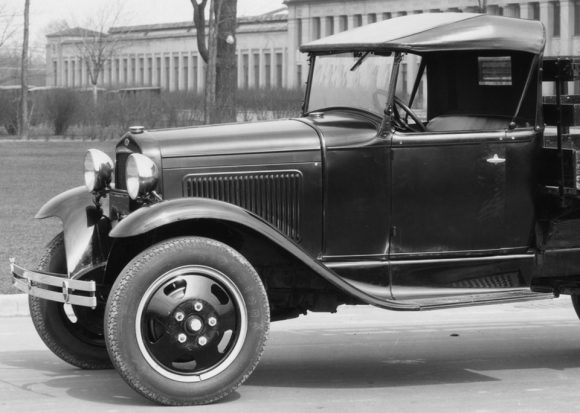2023/11/30 update
| 76-B Open Cab | Production Dates-Count | Supplier | |
|---|---|---|---|
| Start End | A/AA*1 | ||
| Neil Wilson 2018 | |||
| 76-B Open Cab | 06/30 04/32 | 6,560 | Ford |
| *1 – 76-B count includes 545 for June 1930 (50% of total count) | see..FMC ART Adj. | ||
The 76-B open cab is shown below. It was installation on the AA131 and AA157 chassis 6/30—4/32.
Unlike the prior 76-A open cab, it had an integrated cowl and hinge pillar with the belt moulding starting at the front of the cowl and running around the back panel (which had rounded corner).
Since this cab was used on the A-chassis, all body parts were prefixed an A except for the AA floor boards and floor mat.
The 1930 AA with open cab shown below has the optional, extra cost, pin striping. The cab and hood has the standard unpolished commercial body finish.
This AA has been upgraded with the A passenger car stainless steel headlamps. The standard commercial headlamps had black enameled steel cases. The front bumper is the standard A bumper which was used on the AA through September 1930.
The cab doors, cowl, and lower stanchions were the same as used for the Phaeton and Roadster body types.
The d1 lower stanchions were made of brass. Starting in late 1930, the d2 lower stanchions were made of steel. Through service, these new stanchions replaced any broken d1 stanchions.
Upper stanchions had two designs. Both designs were made of steel. They were similar in design to the standard phaeton and standard roadster upper stanchions. But there was no provision for wind wings. And, the vacuum line clips were different with small attachment holes for #6 self-tapping screws.
The d1 upper stanchions were paired with the d1 brass lower stanchions. The d2 upper stanchions were paired with the steel d2 lower stanchions.
Note – For the standard phaeton and standard roadster, the vacuum line on the left stanchion was held by two clips with large holes and secured by the 5/16″ wind wing bracket studs.
The October 28, 1930 Indianapolis service letter contains details regarding this conversion to steel lower stanchions. This was basically a recall resulting in the replacement of both the upper and lower stanchions.

